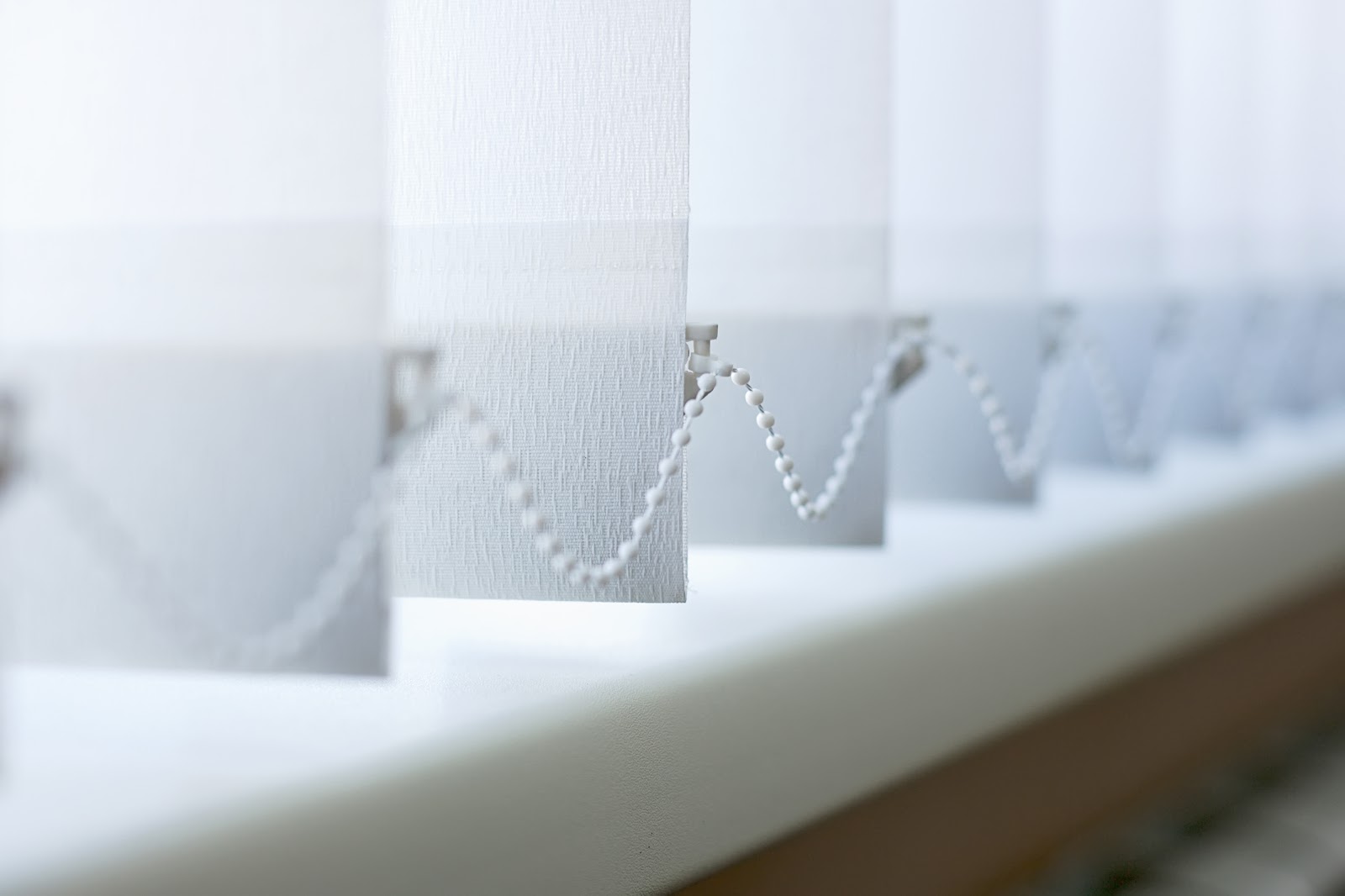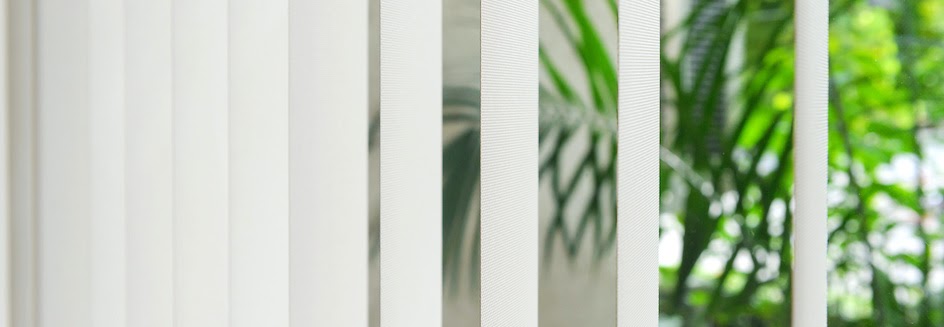If you’ve noticed a build-up of dust and dirt on your vertical blinds, it’s time to give them a good clean. Vertical blinds may attract less dust than other types, but they still need a clean every now and again.
To help you refresh your blinds and keep them looking new, follow this simple guide on how to clean vertical blinds.
What to Know Before You Begin
Before you start cleaning your vertical blinds, you’ll want to double-check which materials they’re made from. Fabric vertical blinds can be washed by hand or in the washing machine, while wooden blinds shouldn’t be soaked at all. It’s also a good idea to read the manufacturer’s notes to see whether you can machine wash your blinds.
In this article, we’ll focus on how to wash vertical blinds made from fabric. For help with cleaning your wooden blinds or venetian blinds, see our dedicated guides on how to keep wooden blinds clean and how to clean venetian blinds.
Vertical Blinds Cleaning Supplies
While fabric blinds can attract dust and dirt easily, they’re also simple to clean. You only need a few cleaning tools plus some water and soap to quickly bring them back to their former glory.
Here are our recommended tools to help you clean your vertical blinds:
- Microfibre cloth
- Vacuum cleaner with a brush attachment
- Mild soap
- Bathtub of warm water or washing machine
- Sponge (for scrubbing tough stains)
- Towels
You’ll also need a surface to lay your blinds out to dry. A dining table works perfectly for this, as it’s best to keep them flat to help them maintain their shape.
How to Clean Vertical Blinds
If you’ve never cleaned your blinds before, it can be hard to know where to start. Luckily, it’s a simple process involving only a few steps. The whole process may take a few hours when you account for drying time, but this is something you’ll only need to do every few months.
Here are three steps to wash vertical blinds in the easiest, most effective way.
1. Remove Blinds and Clean Headrail
The first step in cleaning your blinds is to remove them from the headrail. While you can dust and spot clean with your blinds still attached, this allows you to give the headrail a deep clean at the same time. Plus, it can be easier to soak all your blinds at once in the bath or washing machine than clean them one by one while still attached.
To get started, unhook your blind louvres (slats) from the headrail. Gently take your louvres down and lay them out flat so you can clean the headrail. Grab your microfibre cloth or duster and remove the dust from the headrail.
For tricky places to reach, a can of compressed air can get rid of dust. If you have any silicone spray, give the rails a quick spray to keep everything moving smoothly.
2. Dust Your Blinds
With everything laid out in front of you, use your microfibre cloth to gently remove dust from your blinds. A damp cloth should pick up the dust nicely, but you could also use a traditional feather duster or another cleaning cloth. Move from top to bottom so you capture all the dust and don’t go over areas you’ve already cleaned.
To help remove all the dust, use your vacuum cleaner with a brush attachment. Run this over your blinds from top to bottom on both sides until they’re completely free from dust and debris.
3. Wash Blinds in Warm Water
Now there’s no dust left on your blinds, it's time to wash them. For this, you’ll either want to fill a bathtub with warm water or use your washing machine on a 30 degrees Celsius wash setting. Before you begin, always check whether your blinds are machine washable.
To wash your blinds in the bathtub, fill the tub with a mixture of warm water and a mild soap or detergent. Gently wash your blinds in the water until they look clean. Be careful to avoid hot water, as this can damage blinds, and make sure any detergents you use are suitable for gentle fabrics.
Sometimes, you’ll notice stubborn stains on your blinds. Use a sponge and soapy water to gently buff away at these stains. It can be tempting to use bleach, but this can damage the fabric. If you wish to use a stain remover, first spot test in a hidden area to check it’s suitable.
If you’re washing your blinds in a washing machine, roll them up and secure them inside a pillowcase to help prevent fraying and damage. Use a gentle laundry detergent and use a wash setting designed for delicate fabrics at a temperature no higher than 30 C.
4. Lay Blinds Out to Dry
With your blinds clean and sparkling, you’ll want to lay them out to dry. Avoid hanging them to dry, and instead, find a space where you can lay them on a flat surface. This will help encourage them to maintain their usual shape and prevent damage.
If you need your blinds to dry quickly, try using a hairdryer on a cool setting. Don’t be tempted to put your blinds in the tumble dryer — the heat can seriously damage your blinds.
5. Rehang Blinds on the Headrail
Once your blinds are completely dry, you can begin to rehang them on the headrail. Take care when doing this, especially as you clip each louvre back into place.
Soon you’ll have your blinds back in place and looking refreshed. Now they’re clean, it’s easier to keep on top of a regular dusting schedule and keep them looking as great as possible.
Vertical Blind Cleaning FAQs
While washing your blinds only requires a few tools, some water, and your time, it’s something we don’t always do very often. This means there are plenty of questions about what works best, which products to use, and how to make things easier.
Here are our answers to some frequently asked questions about how to clean vertical blinds.
How Often Should You Clean Blinds?
Avoid dust buildup by dusting your blinds as part of your weekly or monthly cleaning routine. Give them a gentle dusting as you would with other areas of your home, like surfaces and skirting boards.
If you notice a particular stain or stubborn dirt on your blinds, give them a gentle spot clean. Otherwise, treat your blinds to a gentle wash every couple of months. Or, if they’re in a high-traffic area that’s prone to a buildup of grease or dirt, wash them even more often. With regular cleaning and regular maintenance, you should be able to keep your blinds in a better condition for longer.
How Do You Remove Mould and Mildew From Vertical Blinds?
One effective way to remove mildew from vertical blinds is to use a natural cleaning solution that features lemon juice. Lemon is great at tackling mildew spores, especially when combined with natural light from the sun.
Although bleach-based solutions used to be recommended, it’s better to stick to a natural cleaning solution. If you don’t have any lemon handy, a white vinegar mix will help lift some of the mould and mildew and quickly give you clean fabric blinds.
How Do You Clean Vertical Blinds Without Taking Them Down?
Taking your blinds down to clean them means you can tackle all those hidden areas and make sure they’re completely clean. However, there will be times when it’s not practical to do this — especially if you’re short of time or don’t have an easy way to wash and dry them.
To wash your blinds without taking them down, start by dusting them from top to bottom. Use your vacuum cleaner if you can to help remove dust quickly. Next, spot clean your fabric blinds using a mild detergent solution. Try using the solution on a hidden area to make sure it won’t damage the blind fabric. Leave your blinds open to give them as much opportunity as possible to dry.
If you find your blinds get dirty easily and you don’t want to take them down to wash them each time, take a look at our wipe clean vertical blinds. These can be wiped down quickly and easily so you can spend less time cleaning.
Can You Steam Clean Vertical Blinds?
If you have a handheld steam cleaner handy, this can be a great way to quickly wash your blinds. Make sure you’ve removed any dust first, then use the steam cleaner in place of hand washing your blinds. Just be sure to keep the temperature to low or medium heat, and avoid any areas of your blinds that feature plastic or glue.
Refresh Your Vertical Blinds With a Quick Clean
With the blind washing process complete, you’ll be left with clean, fresh blinds decorating your windows and doors. It’s one of those jobs that can often be forgotten, but once it’s done, you’ll notice the difference it makes in your home. Follow this simple guide every time you need to clean your blinds, and you can keep them sparkling and durable for longer.
After cleaning your blinds, you might realise that it’s time to update them with something new. While cleaning should remove most dirt and stains, blinds can still become stained and damaged over time. If it’s time to replace your blinds and create a new look in your home, use our free samples service to help you find the perfect match for your space.



